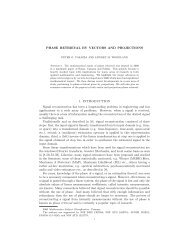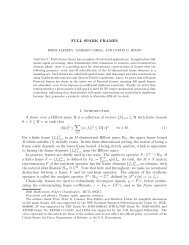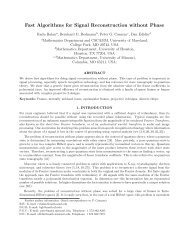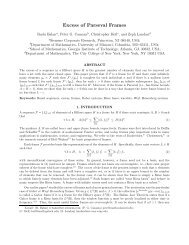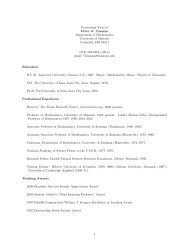Introduction to Finite Frame Theory - Frame Research Center
Introduction to Finite Frame Theory - Frame Research Center
Introduction to Finite Frame Theory - Frame Research Center
You also want an ePaper? Increase the reach of your titles
YUMPU automatically turns print PDFs into web optimized ePapers that Google loves.
<strong>Introduction</strong> <strong>to</strong> <strong>Finite</strong> <strong>Frame</strong> <strong>Theory</strong> 23<br />
Proposition 12. Let T : H N → l M 2 be a linear opera<strong>to</strong>r, let (e j) N j=1<br />
be an orthonormal<br />
basis of H N and let (λ j ) N j=1<br />
be a sequence of positive numbers. By A denote<br />
the N ×M matrix representation of T ∗ with respect <strong>to</strong> (e j ) N j=1<br />
(and the standard unit<br />
basis (ê i ) M i=1 of lM 2 ). Then the following conditions are equivalent.<br />
(i) (T ∗ ê i ) M i=1 forms a frame for H N whose frame opera<strong>to</strong>r has eigenvec<strong>to</strong>rs (e j ) N j=1<br />
and associated eigenvalues (λ j ) N j=1 .<br />
(ii) The rows of A are orthogonal, and the j-th row square sums <strong>to</strong> λ j .<br />
(iii) The columns of A form a frame for l N 2 , and AA∗ = diag(λ 1 ,...,λ N ).<br />
Proof. Let ( f j ) N j=1 be the standard unit basis of lN 2 and denote by U : lN 2 → H N the<br />
unitary opera<strong>to</strong>r which maps f j <strong>to</strong> e j . Then T ∗ = UA.<br />
(i)⇒(ii). For j,k ∈ {1,...,N} we have<br />
〈A ∗ f j ,A ∗ f k 〉 = 〈TU f j ,TU f k 〉 = 〈T ∗ Te j ,e k 〉 = λ j δ jk ,<br />
which is equivalent <strong>to</strong> (ii).<br />
(ii)⇒(iii). Since the rows of A are orthogonal, we have rankA = N which implies<br />
that the columns of A form a frame for l N 2 . The rest follows from 〈AA∗ f j , f k 〉 =<br />
〈A ∗ f j ,A ∗ f k 〉 = λ j δ jk for j,k = 1,...,N.<br />
(iii)⇒(i). Since (Aê i ) M i=1 is a spanning set for lN 2<br />
and T ∗ = UA, it follows that<br />
(T ∗ ê i ) M i=1 forms a frame for H N . Its analysis opera<strong>to</strong>r is given by T since for all<br />
x ∈ H N ,<br />
(〈x,T ∗ ê i 〉) M i=1 = (〈T x,ê i 〉) M i=1 = T x.<br />
Moreover,<br />
T ∗ Te j = UAA ∗ U ∗ e j = U diag(λ 1 ,...,λ N ) f j = λ j U f j = λ j e j ,<br />
which completes the proof.<br />
⊓⊔<br />
4.3 Grammian Opera<strong>to</strong>r<br />
Let (ϕ i ) M i=1 be a frame for H N with analysis opera<strong>to</strong>r T . The previous subsection<br />
was concerned with properties of the frame opera<strong>to</strong>r defined by S = T ∗ T : H N →<br />
H N . Of particular interest is also the opera<strong>to</strong>r generated by first applying the synthesis<br />
and then the analysis opera<strong>to</strong>r. Let us first state the precise definition before<br />
discussing its importance.<br />
Definition 18. Let (ϕ i ) M i=1 be a frame for H N with analysis opera<strong>to</strong>r T . Then the<br />
opera<strong>to</strong>r G : l M 2 → lM 2 defined by<br />
G(a i ) M i=1 = T T ∗ (a i ) M i=1 =<br />
( M∑<br />
) M<br />
a i 〈ϕ i ,ϕ k 〉<br />
i=1<br />
k=1<br />
=<br />
M<br />
∑<br />
i=1<br />
a i (〈ϕ i ,ϕ k 〉) M k=1



